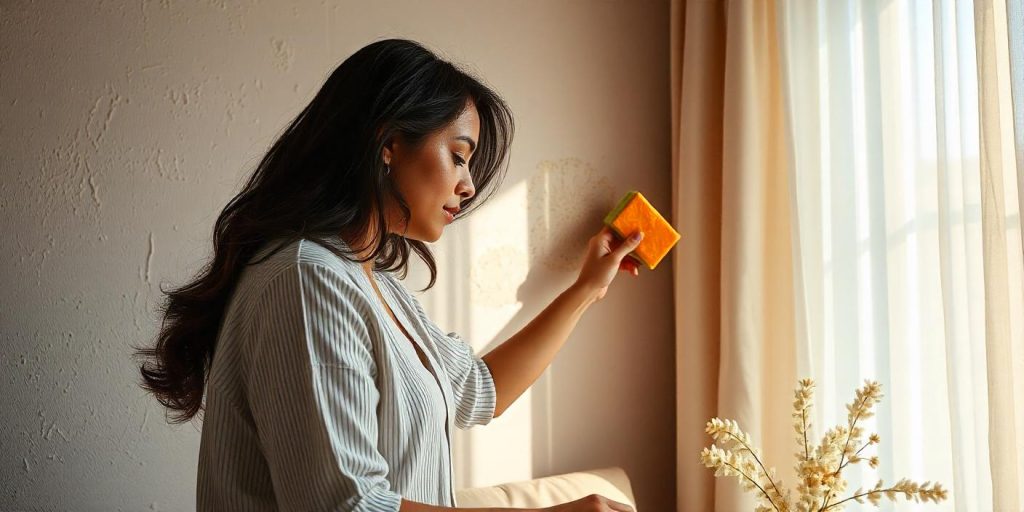Textured paint is a versatile and effective solution for hiding imperfections on your walls. Whether you’re dealing with cracks, uneven surfaces, or old stains, applying textured paint can transform your walls and create a stylish finish.

This guide provides step-by-step instructions to help you conceal wall flaws using textured paint and achieve a professional result.
Contents
- Benefits of Using Textured Paint
- Tools and Materials You’ll Need
- Step 1: Assess the Wall Flaws
- Step 2: Prepare the Wall
- Step 3: Protect Surrounding Areas
- Step 4: Choose the Right Textured Paint
- Step 5: Apply a Base Coat
- Step 6: Apply the Textured Paint
- Step 7: Allow the Paint to Dry
- Step 8: Add Finishing Touches
- Popular Textured Paint Techniques
- Common Mistakes to Avoid
- Maintenance Tips for Textured Walls
- Conclusion
Benefits of Using Textured Paint
Textured paint does more than mask imperfections; it adds depth and character to your walls. Here are some of its advantages:
1. Conceals Imperfections
Textured paint effectively hides cracks, dents, and other surface flaws that traditional paint cannot cover.
2. Enhances Aesthetic Appeal
It creates unique patterns and designs, enhancing the overall look of a room.
3. Increases Durability
Textured paint is often more resistant to wear and tear, making it ideal for high-traffic areas.
Tools and Materials You’ll Need
Painting Tools
- Paint rollers (textured and regular)
- Paintbrushes
- Painter’s tape
Surface Preparation Supplies
- Sandpaper
- Spackle or joint compound
- Putty knife
Cleaning Supplies
- Mild detergent
- Sponge or cloth
Textured Paint Supplies
- Textured paint or paint additive
- Primer (optional, depending on the surface)
Step 1: Assess the Wall Flaws
Identify Problem Areas
Examine the wall to locate cracks, holes, or uneven surfaces that need attention.
Determine the Best Texture
Choose a texture that complements your room’s style and effectively hides the flaws. Options include knockdown, comb, and stucco finishes.
Step 2: Prepare the Wall
Clean the Surface
Wipe down the wall with a sponge and mild detergent to remove dirt, grease, and dust. Let it dry completely.
Repair Cracks and Holes
- Fill cracks and holes with spackle or joint compound using a putty knife.
- Smooth the surface and allow it to dry.
- Sand the repaired areas with fine-grit sandpaper to create an even surface.
Step 3: Protect Surrounding Areas
Use Painter’s Tape
Apply painter’s tape along edges, trim, and baseboards to protect them from paint.
Cover Furniture and Floors
Use drop cloths or plastic sheeting to shield furniture and flooring from splatters.
Step 4: Choose the Right Textured Paint
Pre-Mixed Textured Paint
This is a convenient option that comes ready to use and requires no additional preparation.
Paint Additives
Mix a texture additive into standard paint to create your desired texture.
Specialty Paints
Consider decorative textured paints like sand-textured or stone-look paint for unique finishes.
Step 5: Apply a Base Coat
When to Use a Primer
If your wall has significant imperfections or a bold color that needs covering, apply a primer before the textured paint.
Apply the Base Coat
Use a regular paint roller to apply a base coat in a neutral or matching color. Let it dry completely.
Step 6: Apply the Textured Paint
Methods for Applying Textured Paint
Using a Textured Roller
- Dip the roller into the textured paint and remove excess.
- Roll the paint onto the wall in overlapping strokes.
Using a Brush
For corners and small areas, use a paintbrush to apply the textured paint with a dabbing motion.
Creating Custom Patterns
Experiment with techniques like sponging, combing, or stippling to add a personal touch to the texture.
Step 7: Allow the Paint to Dry
Follow Manufacturer’s Instructions
Check the drying time specified on the paint can. Avoid touching or disturbing the surface during this time.
Step 8: Add Finishing Touches
Apply a Sealant
For added durability and a polished finish, apply a clear sealant over the textured paint.
Touch Up Edges
Remove painter’s tape carefully and touch up any missed spots with a small brush.
Popular Textured Paint Techniques
Knockdown Texture
After applying the paint, use a trowel to flatten the peaks for a softer finish.
Comb Texture
Drag a comb or notched tool through the paint to create patterns.
Stucco Texture
Apply thick layers of textured paint with a trowel for a rough, stucco-like finish.
Common Mistakes to Avoid
Skipping Surface Preparation
Failing to clean and repair the wall can result in uneven texture and poor adhesion.
Applying Too Much Paint
Overloading the roller or brush can cause drips and uneven application.
Rushing the Drying Process
Allowing the paint to dry thoroughly ensures a long-lasting finish.
Maintenance Tips for Textured Walls
Dust Regularly
Use a microfiber cloth or duster to remove dust from the textured surface.
Touch Up as Needed
Keep a small amount of matching paint for quick touch-ups if the texture gets damaged.
Conclusion
Textured paint is a practical and stylish way to hide wall flaws while adding character to your space. By following these steps, you can achieve a professional-looking finish and enjoy a flawless wall that enhances the beauty of your home.
Whether you choose a subtle texture or a bold design, textured paint offers endless possibilities to elevate your interior decor.
